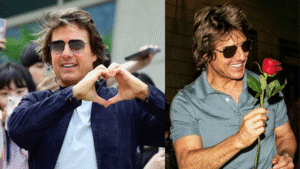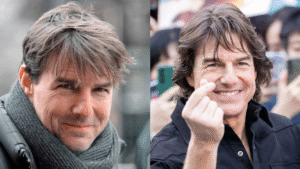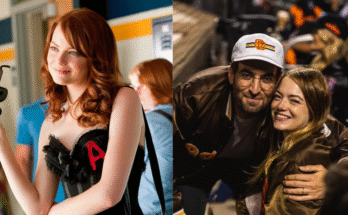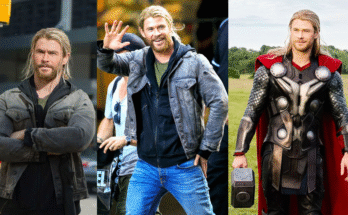The Heart Behind the Machine: Meet Tom Cruise
In an industry obsessed with image and safety, one man built a career by doing his own stunts, taking impossible risks, and refusing to accept that some things can’t be done.
Tom Cruise’s journey isn’t just about becoming a star. It’s about becoming a filmmaker willing to risk everything—his body, his career, his sanity—in pursuit of cinematic excellence.

How a Kid From Upstate New York Became Hollywood’s Most Bankable Star
The Complicated Beginning: Poverty and Religious Upheaval
December 3, 1962 – Thomas Cruise Mapother IV was born in Syracuse, New York, to Thomas Cruise Mapother III, an electrical engineer and former fighter pilot, and Mary Lee Pfeiffer, a teacher.
On the surface, a normal middle-class family. But beneath was complexity:
The Family Dysfunction:
- His father was an alcoholic and emotionally abusive
- His mother was spiritually searching and unstable
- The family moved constantly (11 times by age 12)
- His father abandoned the family when Tom was 11
- Young Tom became the man of the house at age 11
The Religious Journey:
- Raised Catholic initially
- Struggled with identity and belonging
- No stable foundation during formative years
- Felt the weight of family collapse at young age
The Outsider: Always Moving, Never Belonging
Due to constant moves, Tom was:
The Pattern:
- New kid repeatedly, always the outsider
- Had to constantly rebuild friendships
- Developed survival skills through adaptation
- Learned to reinvent himself in new schools
- Never had roots or stable community
The Compensation: Unable to feel at home, Tom threw himself into:
- Sports (football, hockey, baseball)
- Theater and performance
- Academics
- Anything to feel achievement and connection
The Realization: Acting wasn’t just about performance. It was about finding identity through inhabiting different characters.
The Invisible Years: From Unknown to Rising Star (1981-1985)
Early Small Roles: Building Foundation
Tom’s early career involved:
“Endless Love” (1981) – Film debut, uncredited role “Losin’ It” (1983) – Comedy film, small role “The Outsiders” (1983) – Cult classic with ensemble cast “Risky Business” (1983) – Breakout role as Joel Goodsen
The Turning Point:
“Risky Business” was the role that changed everything. Tom played a high school student navigating coming-of-age temptations and his parents’ expectations.
The Performance:
- Charismatic, vulnerable, authentic
- The famous scene of sliding across the floor in socks became iconic
- Showed him as bankable star
- Made him instantly recognizable
The Significance: Tom proved he could carry a film and attract audiences. He wasn’t just handsome—he was compelling.

The Ascension: From Breakout to Superstardom (1984-1990)
“Top Gun” (1986) – The Iconic Role
Director Tony Scott cast Tom as Maverick, a cocky fighter pilot with something to prove.
Why It Became a Phenomenon:
- Military recruitment imagery
- High-octane action sequences
- Romantic subplot with Kelly McGillis
- Infectious energy and charisma
- Perfectly tapped into 1980s zeitgeist
The Box Office:
- Grossed $356 million worldwide
- Became one of highest-grossing films of 1980s
- Made Tom a global superstar
- Changed the action film landscape
The Reality: Tom had finally arrived. He was bankable. He was famous. He could have coasted on “Top Gun” success forever.
Instead, he started taking risks.
The Strategic Diversity: Refusing to Be Typecast
Rather than making “Top Gun” sequels, Tom made bold choices:
“Rain Man” (1988):
- Drama with Dustin Hoffman
- Supporting role to Hoffman’s lead
- Oscar-nominated film
- Showed dramatic range
- Earned respect beyond action stardom
“Born on the Fourth of July” (1989):
- Serious drama about paralyzed Vietnam vet
- Physically demanding role (lost weight, learned to move as paraplegic)
- Academy Award nomination
- Showed commitment to craft
- Proved he could carry dramatic work
“A Few Good Men” (1992):
- Legal thriller ensemble cast
- Intense monologue scene
- Showed he could work with heavyweight actors
- Blockbuster success ($243 million)
The Pattern: Tom wasn’t just making action films. He was building credibility as a serious actor while maintaining commercial success.
The Middle Phase: Establishing Bankability (1993-2000)
“The Firm” (1993) – $270 million worldwide
“Interview with the Vampire” (1994) – $220 million worldwide
“Mission: Impossible” (1996) – $457 million worldwide
“Mission: Impossible” Significance:
When director Brian De Palma cast Tom in the lead of an action-espionage franchise, it became:
- One of highest-grossing films
- Launched franchise that would define his career
- Showed he could carry pure action blockbusters
- Grossed nearly $500 million worldwide
- Proved his box office power was consistent
The Perfectionism Emerges
During “Mission: Impossible” production, something became apparent:
Tom’s Working Style:
- Demanded multiple takes until perfect
- Studied every scene meticulously
- Collaborated intensely with directors
- Often stayed late on set
- Never settled for “good enough”
The Effect: This perfectionism sometimes made him difficult to work with, but it also ensured every Tom Cruise film maintained high quality.

The Dangerous Years: Doing His Own Stunts (2000-Present)
The Philosophy: If It’s Dangerous, Tom Does It
Around the year 2000, Tom made a decision:
“I don’t want to watch someone else do my stunts. I want to do them myself.”
This wasn’t bravado. It became his career-defining principle.
“Mission: Impossible” Films – The Evolution
“Mission: Impossible 2” (2000):
- Did climbing and motorcycle stunts personally
- Started the trend of Tom performing dangerous sequences
“Mission: Impossible III” (2006):
- Increasingly dangerous stunts
- Tom performed more of the action himself
“Mission: Impossible – Ghost Protocol” (2011):
- Climbed the Burj Khalifa (world’s tallest building)
- Personally did stunts 828 meters high
- No green screen, no safety net
- Risked his life for authenticity
“Mission: Impossible – Rogue Nation” (2015):
- Hung from aircraft while flying
- Did underwater sequence (held breath for 6 minutes)
- Personally performed increasingly dangerous stunts
“Mission: Impossible – Fallout” (2018):
- Crashed helicopter for opening sequence
- Jumped between buildings
- Nearly died performing HALO jump scene
- Broke ankle during stunt, kept filming
“Mission: Impossible – Dead Reckoning Part One” (2023):
- Drove motorcycle off cliff
- Most expensive action sequences ever filmed
- Personified the commitment to realism
Why This Matters
Tom’s Stunt Commitment:
- Elevates action filmmaking by forcing real consequences
- Other actors become inspired to do more
- Action sequences gain authenticity that CGI can’t match
- Audiences feel the reality of danger
- Creates cinematic impact impossible with digital effects
The Industry Impact: Tom essentially transformed action filmmaking. Directors now expect actors to do more of their own stunts. The industry standard raised because Tom refused to fake it.
The Box Office Dominance: Numbers That Define Immortality
Mission: Impossible Franchise:
- “Mission: Impossible” (1996) – $457 million
- “Mission: Impossible 2” (2000) – $546 million
- “Mission: Impossible III” (2006) – $398 million
- “Mission: Impossible – Ghost Protocol” (2011) – $694 million
- “Mission: Impossible – Rogue Nation” (2015) – $686 million
- “Mission: Impossible – Fallout” (2018) – $791 million
- “Mission: Impossible – Dead Reckoning” (2023) – $567 million
- Total: $4.1+ billion from MI franchise alone
Other Massive Hits:
- “Top Gun” (1986) – $356 million
- “Top Gun: Maverick” (2022) – $1.49 billion (one of highest-grossing films ever)
- “Jerry Maguire” (1996) – $273 million
- “The Last Samurai” (2003) – $456 million
- “War Horse” (2011) – $536 million
- “Edge of Tomorrow” (2014) – $402 million
Career Box Office:
- Films grossed $10+ billion collectively
- One of the most bankable stars in cinema history
- Most consistent box office draw across 40+ years
Net Worth:
- Estimated $600+ million
- Earned through combination of acting fees and backend deals
- Built financial empire through strategic choices

Personal Life: The Controversial Icon
Marriages and Relationships
First Marriage: Mimi Rogers (1987-1990) Second Marriage: Nicole Kidman (1990-2001)
- Met on “Days of Thunder” (1990)
- Married 11 years
- Had two adopted children (Isabella and Connor)
- Divorced amicably
Third Marriage: Katie Holmes (2006-2012)
- Highly publicized relationship
- Had daughter Suri
- Divorce was contentious and public
- Remains involved in daughter’s life
Scientology: The Defining Controversy
Tom’s involvement with Scientology since 1986 has been:
The Public Perception:
- One of most famous adherents
- Used platform to promote the religion
- Donated millions to the organization
- Outspoken about its benefits
- Created controversy and criticism
The Impact:
- Some view him as cult evangelist
- Others respect his right to beliefs
- Affected some business relationships
- Created divisions among fans and colleagues
The Reality: Tom’s Scientology involvement is part of his public narrative, whether positive or negative depending on perspective.
The Age Question
As Tom entered his 50s and 60s, he:
Defied Aging Stereotypes:
- Continued doing increasingly dangerous stunts
- Remained bankable for massive action films
- Refused to retire or slow down
- “Top Gun: Maverick” at age 60 grossed $1.49 billion
- Proved that aging doesn’t mean irrelevance for men (unlike women in Hollywood)
The Secret Behind Tom’s Unstoppable Dominance
Lesson 1: Perfectionism Is an Asset
Tom’s demand for perfection drives everyone around him to excellence. His films are consistently high quality because he won’t settle for mediocrity.
Lesson 2: Diversify Across Genres
Tom didn’t remain an action star only. He did drama, comedy, and everything in between. This prevented typecasting and maintained relevance.
Lesson 3: Take Real Risks
Tom’s willingness to do dangerous stunts isn’t reckless—it’s strategic. It creates authentic action sequences that audiences can feel.
Lesson 4: Longevity Requires Reinvention
Tom didn’t retire when his early stardom faded. He reinvented with “Mission: Impossible” franchise and remained relevant for decades.
Lesson 5: Build Franchises, Not One-Off Hits
Rather than making random action films, Tom built the Mission: Impossible franchise into a multi-billion dollar empire spanning 30+ years.
Lesson 6: Command Respect Through Quality
Tom became so bankable that studios would finance almost anything he wanted, not through nepotism but through proven track record of success.
The Controversial Legacy
The Criticisms
Tom Cruise isn’t universally beloved:
The Controversies:
- Scientology involvement and proselytizing
- Perceived as difficult on set
- Aggressive pursuit of public image control
- Disconnect from reality due to wealth/fame
- Questions about his private life
The Reality: Tom’s image is carefully managed and controlled. Some view this as manipulative; others view it as strategic branding.
The Defense
Why People Still Support Tom:
Despite controversies, Tom maintains loyalty because:
- His films deliver genuine entertainment
- He appears committed to his craft
- His stunts create cinematic experiences others can’t
- He’s built a reliable brand
- His business instincts have been sound
The Journey: Before & After
| Aspect | The Struggling Actor (1981-1985) | The Action Legend (1986-Present) |
|---|---|---|
| Recognition | Unknown, bit parts | Global superstar |
| Financial Status | Modest actor income | $600+ million net worth |
| Career Control | Taking any role available | Choosing only best projects |
| Box Office Power | None | $10+ billion from films |
| Award Recognition | None | Multiple nominations |
| Franchise Value | None | $4.1+ billion from MI alone |
| Physical Risk | Standard action choreography | Doing real, dangerous stunts |
| Industry Influence | None | Changed how action films made |
| Global Reach | Limited | Recognized in 200+ countries |
| Longevity | Uncertain future | 40+ year career still going |

The Bottom Line: Why Tom’s Story Matters
Tom Cruise proved that an ordinary kid from a broken home can become one of cinema’s greatest action stars through perfectionism, strategic choices, and willingness to take real risks.
He could have:
- Remained type-cast after “Top Gun”
- Relied on stunt doubles like other actors
- Retired when box office power faded
- Settled for mediocre films for quick money
Instead, he: ✓ Diversified across genres and maintained credibility ✓ Did increasingly dangerous stunts personally ✓ Built the Mission: Impossible franchise into empire ✓ Remained bankable for 40+ years ✓ Raised industry standards through perfectionism ✓ Refused to age out of leading roles ✓ Built $600+ million empire ✓ Changed action filmmaking forever
Key Takeaways for Ambitious Creatives
🎬 Perfectionism compounds over decades 🎬 Diversification prevents typecasting 🎬 Real risk creates authentic art 🎬 Franchise building creates lasting wealth 🎬 Longevity requires constant reinvention 🎬 Command respect through consistent quality 🎬 Age doesn’t mean decline if you refuse it 🎬 Strategic image control is business, not vanity 🎬 Broken beginning doesn’t determine ending 🎬 Mastery requires commitment to craft above all
Tom Cruise’s Defining Words
“If you have a problem, if no one else can help, and if you can find me, maybe you can hire me.”
“I do my own stunts because I believe it matters. The audience can feel the difference between real and fake.”
“Work is hard. Diligence is hard. Commitment is hard. But it’s not as hard as not knowing what you want to do.”
“I want to work with people that I respect, and I want to make films that I’m proud of.”
The Continuing Evolution
In his early 60s, Tom continues to:
- Make Mission: Impossible films with increasingly dangerous stunts
- Command $15-20 million per film
- Maintain perfectionist standards
- Refuse to slow down or retire
- Remain one of most bankable stars
- Continue pursuing cinematic excellence
The Real Tom Cruise Story:
Not just a man who became a star. But a man who:
- Rose from broken, unstable childhood to global icon
- Refused to be limited by his past
- Built career on perfectionism and quality
- Diversified to prevent obsolescence
- Took real physical risks for authenticity
- Built franchise that generates billions
- Maintained relevance across 40+ years
- Raised industry standards through commitment
- Proved that age doesn’t mean irrelevance if you refuse it
In a world of manufactured celebrities and disposable stars, Tom Cruise represents the power of commitment to craft, willingness to take real risks, and absolute refusal to settle.
That’s not just a career. That’s a legacy.



